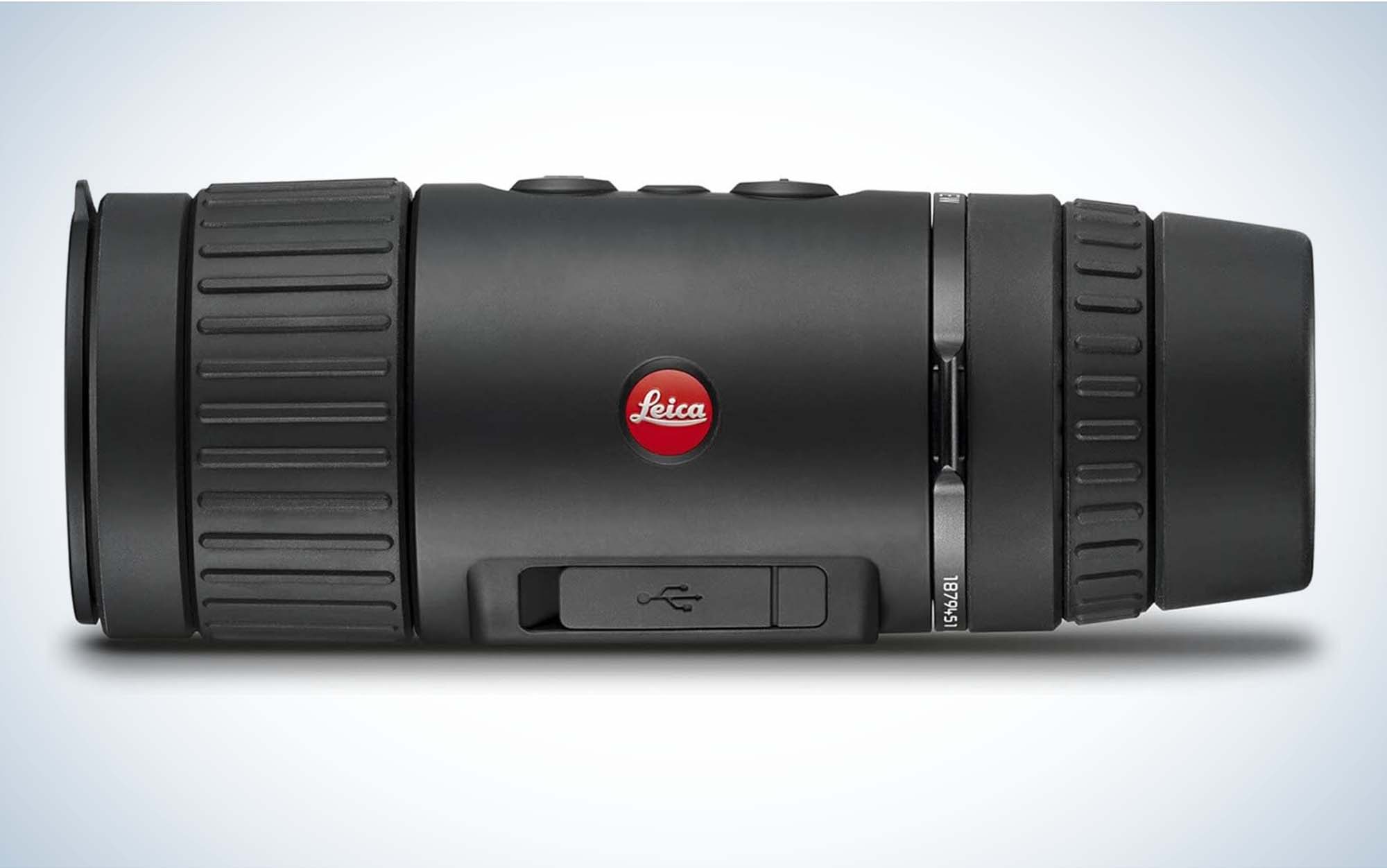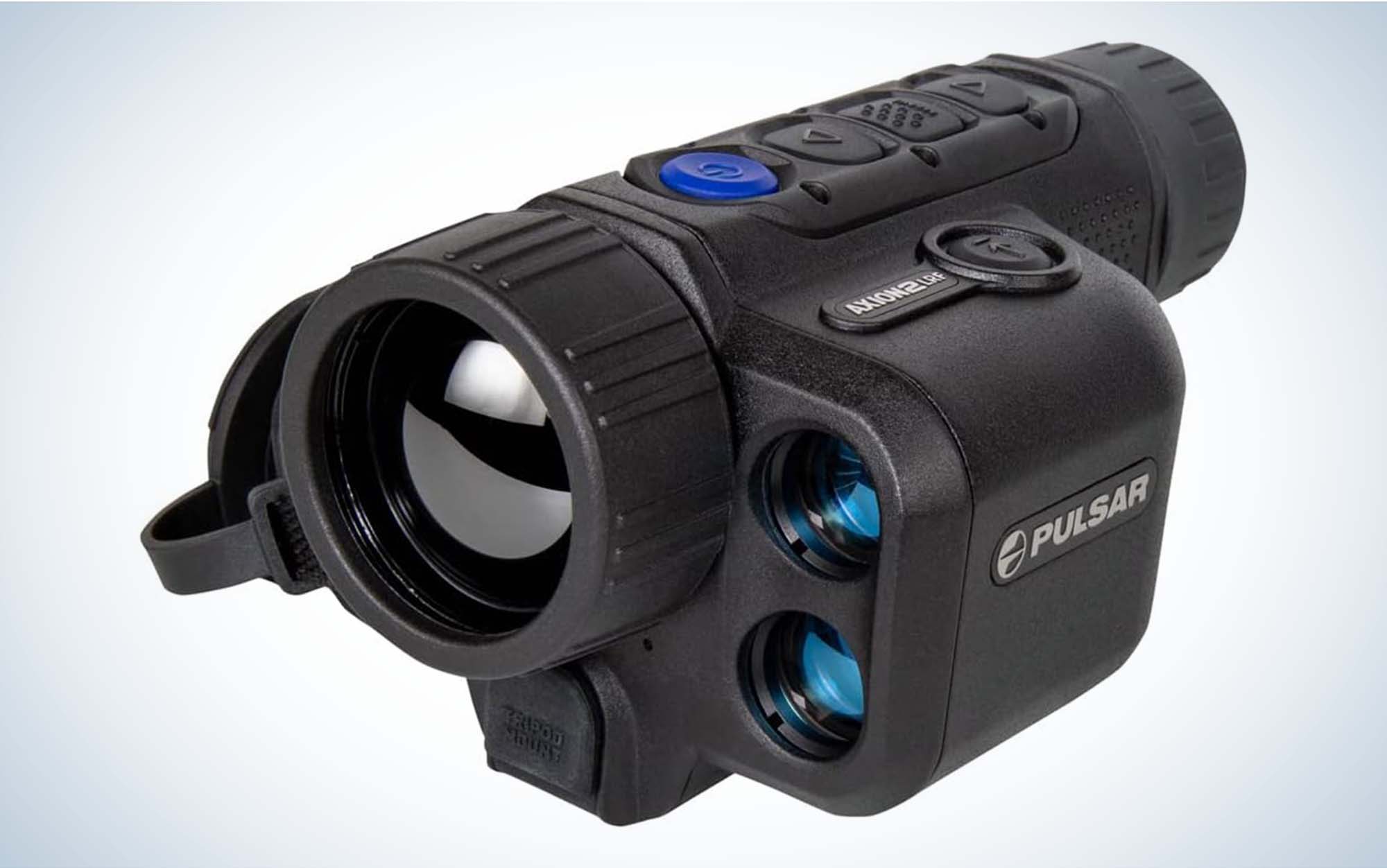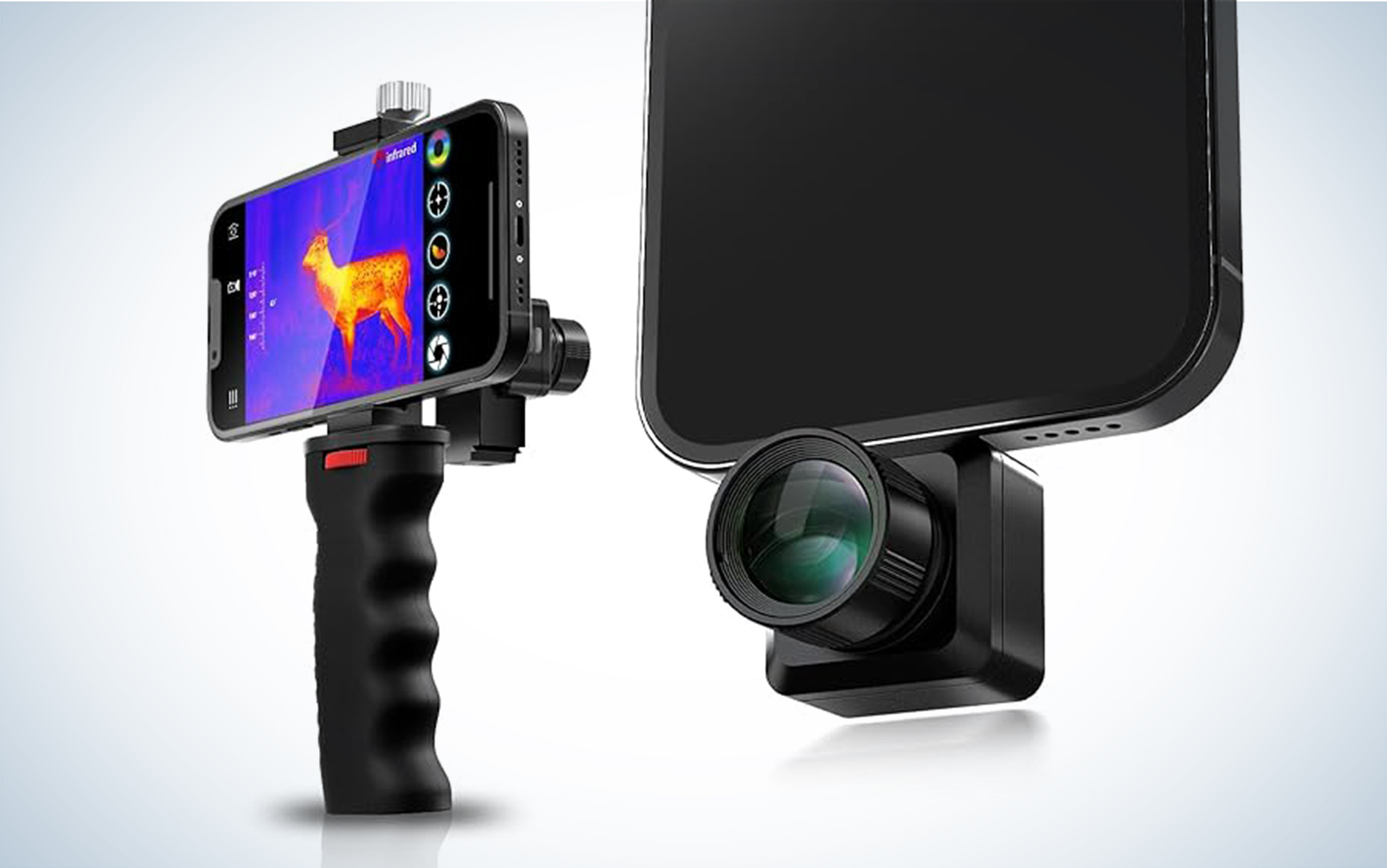We may earn revenue from the products available on this page and participate in affiliate programs. Learn More ›
Everybody wants to know what goes bump in the night, even if it doesn’t bump and even if it’s not nighttime. Happily, thermal monoculars, a new and energetic category of gear, helps identify what used to be invisible. They can help you see everything from human intruders on the other side of a fence, to coyotes and raccoons crouching in the dark, to a problematic wire in a household electrical outlet.
We’re talking about monoculars, rangefinders, and cameras that use temperature variations, rather than visible light, to form images that can be captured as photographs or videos, or simply delivered to your eye to answer that ancient question: what’s out there?
I’ve used this new class of “optics” over the past year to find newborn calves in a deadly blizzard, to find my ice-fishing buddies in the fog, to detect hidden electrical problems that might burn my house down, to hunt coyotes at midnight, and to finally even the odds on crop-raiding feral hogs. You could also use them to recover wounded game where it’s legal.
Here are my picks for the best thermal monoculars, which range from flashlight-looking monoculars to small thermal viewers that connect to smartphones.
How I Tested the Best Thermal Monoculars
The field includes brand-new units that are just hitting the market this winter, others that I’ve tested over the course of the past year, and a few oddballs. My intention wasn’t to test every unit on the market, but rather handle a representative sample of products in order to provide a performance baseline. Also note that we’re not covering thermal rifle scopes in this particular roundup.
I started by measuring attributes, assessing how far each thermal monocular could effectively detect a standard chemical hand warmer in the dark.
I then used each unit on midnight-shift rounds of a calving operation to detect cows that wander away from the herd at night to give birth. The thermal mapping capability of these viewers can even show which cows are close to calving based on rising abdominal temperature.
I also used the thermals on a series of sub-zero winter coyote and cottontail hunts to test their capabilities in the field and assess how their batteries would hold up to extreme cold.
I enlisted the help of a digital (and thermal) native, Kaden Fossum, who independently tested all the units over the course of the fall and winter from his home in southeast Montana. Fossum measured the range, thermal sensitivity, and field-worthiness of each unit over several weeks of coyote hunting. Most of the videos and images that accompany each product review is from Fossum’s field work.
Both Fossum and I assessed each unit’s imagery, both the type and utility of the palettes available and the resolution of the images. And we scored each unit’s ease of use and ergonomics.
Best Thermal Monoculars: Reviews and Recommendations
Best Overall: Leica Calonox View
Key Features
- 2.5x optical magnification and up to 4x digital zoom
- 3,000-meter range, 1,000-meter detection range, 500-meter target-identification range
- Excellent battery life
- Sensor size: 640×512 pixels
- Screen resolution: 1280×960 pixels
- 16 GB internal memory
- High-definition LCOS display
Pros
- Three-button operation is simple and ergonomic
- Excellent photo/video resolution and contrast
- Connects to smartphone via Calonox View App
- Tripod-mountable
- Durable solid-state build, manufactured in Germany
- Same controls and design as Leica’s Colonox clip-on sight
Cons
- At over $3,700, it’s a pricey unit
- Limited viewing options
European optics brands were early adopters of thermal technology. This makes sense, since companies like Zeiss, Leica, and Swarovski have vast resources devoted to imaging, and since their core customers—European deer and boar hunters—are allowed to hunt at night.
Most of these brands now have very capable clip-on thermals, units that attach to a conventional riflescope, but they do a pretty vigorous business with their hand-held monoculars, and the Calonox View from Leica is one of the best of the bunch. It has remarkable resolution, a very crisp display, and a range that allows users to scan wide and deep swaths of landscape.
The unit has talents as a close-in tracking aid, and a decent thermo-detector in household and industrial settings, but it’s built for investigating distant objects. It can capably pick up thermal differentiations out to 3,000 yards, but its ability to parse targets out to 500 yards makes this a very effective predator and wildlife-viewing monocular. When mounted to a tripod, its panning feature is almost cinematic. In his assessment of both thermal viewers and riflescopes, Fossum said the Leica hand-held viewer and clip-on provided the best resolution of any product he tested at distances beyond 1,000 yards.
The quality of its image, sharp, contrast-y, and vivid, separates the Leica from most of its peers. As you might expect from a brand that’s synonymous with the best European optics, the Colonox View elevates the thermal viewing experience. It also shines operationally. The Colonox has three buttons in a row along its top surface, spaced a little like those of a trumpet. The middle button operates most functions, and the other two help users toggle between menu choices. Smart, simple, and very effective in the heat of the moment in the field.
If the Leica lacks any feature, it’s the wide variety of color palettes—the Colonox has only four choices—and viewing options like frame-within-a-frame or virtual reticles, which have become standard on other brands’ viewers.
The Colonox connects seamlessly with Leica’s Colonox View mobile app. The app interface is a little clunky, but it serves as an adequate conduit for images and videos off the monocular. And, because those images are rendered so clearly and cleanly, you’ll probably be like me, showing all your friends the best version of your world at night.
Best Rangefinding: Pulsar Axion 2 LRF XG35
Key Features
- 1,900-yard detection range
- 1,100-yard laser rangefinder
- 2.5-20x magnification
- Photo and video recording (50 Hz frame rate) and Wi-Fi image transmission
- Tripod-mountable
- 640×480 sensor resolution
- 1024×768 display resolution
Pros
- At .6 pounds, very lightweight and portable
- Connects to excellent Stream Vision 2 mobile app
- Durable magnesium-alloy chassis
- 8 color palettes available
- Good cold-weather battery performance
- Excellent button arrangement and tactility
Cons
- At $4,199 MSRP and $3,000 real-world street price, it’s a pricey unit
- Rangefinder module adds bulk

This may be the ultimate thermal spotter, capable of not only scanning the landscape in high resolution and detecting thermal signatures out to 2,000 yards, but providing precise distance to objects—both reflective and non-reflective—beyond 1,000 yards.
The Pulsar’s range and resolution make it a great search-and-rescue aid, and at 12.3 ounces and 6 inches long, it’s compact and portable. The magnesium-alloy frame is durable, and Fossum was reasonably pleased with its battery life, though below about 10 degrees F, run time was cut in half to 3 or 4 hours between charges.
Optically, the Axion 2 zooms from 2.5x up to 20x, though at the top-end magnification, images lose resolution. It’s at its best as a landscape scanner, panning at lower magnifications, then zooming in on a specific object to get a precise distance. The unit’s 640×480 microbolometer sensor is fairly standard, but the Axion 2’s excellent display—1024×768 resolution—delivers crisp and clear images in any of its eight color palettes.
Like other Pulsar thermals, the Axion 2 has built-in photo and video recording, and by connecting to the brand’s Stream Vision 2 mobile app, users can either download images to their photo library or store them in the app. The app’s ability to pair with a smartphone mirrors the image on the phone’s screen, allowing a companion to have the same in-optic view as the user.
The Axion 2 LRF XG35 is the rangefinder-enabled version of Pulsar’s original XG35 Thermal Monocular. That device has been on the market for a couple of years and is found in a surprising number of Western search-and-rescue go bags. From a pricing standpoint, the original XG35 carries a street price of about $2,500; the LRF version runs about $3,000. Is the added laser rangefinder worth $500? I’d argue that it is, especially if you’re running and gunning with a buddy who has a lower-wattage thermal scope or if you need a high-power thermal viewer for industrial or public-safety reasons.
Best Entry-Level: FLIR Scout TKx
Key Features
- 160×120 sensor resolution
- 640×480 display resolution
- Internal lithium-ion battery
- Eye bellows blocks ambient light
- Very simple operation
Pros
- Extremely light (6 ounces) and compact
- Simple and ergonomic button arrangement
- 7-hour battery life in moderate temperatures
- Robust color palettes: white hot, black hot, InstAlert, rainbow iron, lava, color wheel, Graded Fire 1&2
- Picture and video image capture
- At about $500, one of the most affordable thermal monoculars
Cons
- Disappointing resolution
- Range limited to about 100 yards
With its Scout TK, FLIR provides consumers with a capable and affordable thermal viewer that can be considered a backyard and campsite unit. This flashlight-shaped monocular will wow your kids and their friends by detecting objects at night, and it is a very useful tracking device for hunters and other outdoors folk.
The Scout TK has more color palettes than its big brother, FLIR’s Scout II, and it has a very sensible and straightforward operation that allows users a short learning curve. Also in the plus column: a useful ballistic nylon carrying case, robust 7-hour battery run time, and plug-and-play video and image retrieval. The Scout TK also has a two-year warranty, which is among the best in its entry-level class.
On the deficit side of the ledger, the small objective lens combined with its puny sensor renders images small, dark, and fuzzy. The detection range extends only 100 yards, so it’s not a good choice for predator hunters or anyone who wants confirmation if that distant thermal blob has two legs or four. If you’re looking for a viewer that will allow you to detect subtle variations in textures, or even to count points on a deer in the dark, this isn’t the unit for you. Instead, you’ll get decent renderings of large objects with strong temperature differentiations, and the 640×480 display is actually very good, considering the size and price of the Scout TK.
Bottom line: this is a great starting thermal, and a very handy aid for the majority of uses that casual consumers ask a thermal unit to fulfill. But its shortcomings will be apparent to those who pick up a more advanced (and pricey) thermal and look into the night.
Best Phone-Enabled: Xinfrared T2 Pro
Key Features
- Tiny 1-inch-square size
- 2-15x digital zoom
- Records video and still images
- 7 reticle choices
- Visibility of deer-sized target: 787 yards
- 6 thermal palettes
- High-definition video mode
Pros
- Extremely portable
- Plug-and-play simple
- No on-board power supply
- Accessibly priced at about $400
- Connects facing either toward or away from user
- Excellent mobile app interface
Cons
- Unit may not connect through some phone cases
- Poor image resolution
- Questionable durability
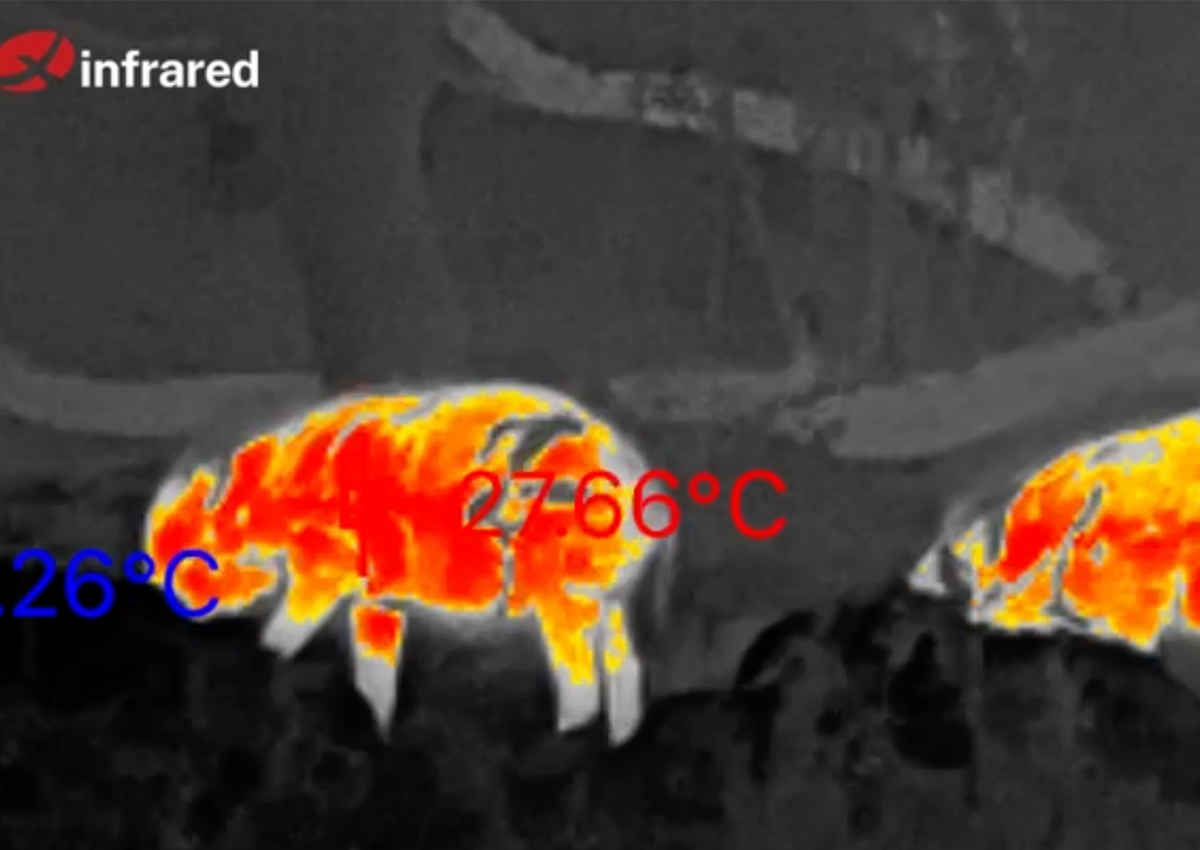
I have spent more time over the past year with this tiny, remarkable thermal camera than with any other single thermal in this collection. Partly that’s because its size (about the size of your iPhone’s wall charger) and portability made it a cinch to take on every hunt and outdoor adventure. Partly it’s because the ease of use—the Xinfrared T2 Pro connects to the power port of your smartphone—turns my phone into a very capable thermal viewer and camera.
You can read my longer review of the T2 Pro here, but the value proposition of this tiny device is its go-everywhere, do-anything utility along with its accessible $400 price. If you’re looking for an entry-level thermal that can show the capabilities of this relatively new category of gear, this is a great place to start.
I took my test sample to Africa, where laws prohibiting thermal use for hunting situations aren’t as rigorous as they are in North America, and I used it to take a gold-medal class bushpig over a nighttime bait site. I used it to find my way out of bowhunting stands in the dark without bumping animals. The unit is so small, portable, and handy that I keep it in my hunting kit for emergencies. If I had to find a lost companion at night, I’d use this device. I’d use it to confirm that my campfire was truly out cold. And I’d use it to scan trailside brush in grizzly country to confirm that I’m not about to be ambushed.
Note that the T2 Pro isn’t the first or the only of these mini thermal monoculars. Years ago, FLIR introduced its ONE Pro, which, like the Xinfrared, attaches to the power port of mobile phones. And Leupold had its LTO-Tracker, a flashlight-looking thermal monocular. A Google search turns up plenty of variations on the general idea of a detachable thermal camera that connects to a phone’s power port. But Leupold no longer sells its LTO. The FLIR camera is about twice the size of the T2 Pro and doesn’t have independent focus.

The imaging and display resolution of the T2 Pro is pretty underwhelming. Both the T2 and T2 Pro have a pixel size of 12 microns; that’s on the very low end of what’s available on the market. The T3 has finer resolution, with 17-micron pixels and a resolution of 384 x 288 pixels. Both the T2 models have resolution of 256×192 pixels. That’s actually pretty lousy compared with larger thermal units that often have 640×480 pixel resolution.
The micro monocular makes up for its underwhelming resolution by using your phone’s screen to display the image, and as you’ve probably observed, most cell phones do a good job of image enhancement. The Xinfrared’s mobile app deserves special attention. It not only displays the camera’s image, but it controls its operations; there are no buttons or switches on the thermal unit itself. The unit connects to the Lightning Port (charging port) of my iPhone, and can face either outward, in the direction of the phone’s main camera, or inward, in the direction of the phone’s screen. Once connected to the phone, with the Xinfrared app powered up, the camera starts transmitting thermal images. The thermal device receives its power from the phone itself. That’s an important consideration, since thermal units suck on-board batteries dry, especially in cold weather.
You can record in either video or still-image modes. Video records in either HD or standard resolution. Thermal palettes include white hot, black hot, red hot, hot rainbow, rainbow, and an oddball mode called “birdwatching. Other features include a centering reticle that can be turned on or off, an accelerometer that measures the unit’s velocity, and a compass that shows the unit’s spatial orientation. The unit also captures lat/long GPS coordinates.
To my eye, the best feature of the T2 Pro is its manual focus. Many thermal monoculars—even those many times the size of this midget device—have fixed focus. Those units are optimized for mid-distance objects. Too far out, and the focus can’t create hard edges, and too close and the objects are fuzzy. I was able to focus from about 2 feet out to near infinity. The unit has a stated distance range of 787 yards for deer-sized objects, and while I didn’t confirm the measurement, that’s about right based on my experience.
Hand-holding your phone while deploying the T2 Pro isn’t ideal. I had to remove my phone’s case in order to get the thermal to fit snugly in the Lightning Port, and without the case, the phone was hard to keep still. I’d recommend getting a selfie stick or some other bracket to hold your phone if you do much recording with the thermal. If you’re anything like me, you’ll be doing a lot of viewing and videoing with this remarkable diminutive thermal viewer and camera.
Read Next: Best Thermal Cameras
Best for Hunting: Zeiss DTI 3/35
Key Features
- Standard palettes: white hot, black hot, red hot, rainbow, red hue, green hue, dark hue, “Green Eye”
- 1-4x magnification
- Manual focus
- Eyepiece diopter
- 1,400-yard range
- 384×288 sensor resolution
- 1024×768 display resolution
Pros
- Intuitive ergonomics and button controls
- Best-in-class battery run time
- Excellent resolution for the price
- Very good compatibility with mobile app
- More color palettes and image modes than its peers
Cons
- At about $3,000, it’s a fairly expensive unit
- Limited range compared with peers
If you’re going to spend $3,000 on a thermal viewer, you have certain expectations. It had better deliver a great image. It should have photo and video recording capabilities that are transferable via a mobile app. And it should hold up to all the abuses of the field, which are compounded at night.
Zeiss’s flagship thermal monocular, the DTI 3/35, delivers all those attributes, but what elevates this product above its European peers is that it’s the bottom rung of a family of thermal viewers that offer more features, more intense imaging, and higher prices as you climb the ladder. As an example, the DTI 3/35 brings a 1,500-yard detection range to the game, but its big brother, the DTI 4, can deliver images out to 3,000 yards.
But back to the DTI 3/35. It’s plenty powerful for most American hunters and outdoors folk, and because its imaging is so clear, crisp, and so obviously on the next level compared to most of the thermal monoculars on the market, I’d argue this is all you need. The monocular is designed to fit comfortably in an open hand, and the control buttons are accessible and thoughtfully placed to enhance fast and efficient operation.
This handy, simple hand-held unit is a happy marriage of Zeiss’s optical heritage and electronic capability. There’s nothing fancy about this – it doesn’t have a rangefinder or a reticle – but it offers good resolution in a durable and intuitive package.
The 35mm objective is the DTI’s strongest attribute. That’s a fair amount of germanium crystal for a hand-held unit — about three times as much as the FLIR mentioned above — and provides very good resolution. It has a simple still and video capture mode and has wireless transmission capability. And the battery life was among the best in this roundup. I managed to get 9 hours of continuous run time in moderate temperatures and up to a month of power with intermittent use.
Unlike its obvious peer in this collection, the Leica Colonox View, the Zeiss has eight color palettes, including popular black-hot and white-hot, but also red-hot, rainbow, and four additional palettes that adjust images to the environment. It also features a detection mode, a “hot-tracking” feature, picture-in-picture mode, compass overlay, and programmable buttons to create shortcuts to its various abundant features.
If there’s a knock on the Zeiss, it’s that its sensor and display aren’t quite as powerful or crisp as its European competitors. The Zeiss reaches out to 1,400 yards, and its 384×288 sensor resolution is adequate for most purposes, but it can muddy images compared with other top thermal monoculars.
On the plus side, the .92-pound, 7.6-inch torpedo-shaped device slips into most pockets, and its intuitive controls make nighttime deployment a cinch. Connecting to the Zeiss Hunting App is easy, and the 32 GB internal memory means that you can record for days before you need to transfer image files to the app.
There’s really no downside to the Zeiss. As a matter of brand allegiance, if you stick with the Zeiss ecosystem, you can step up to truly powerful thermal monoculars and clip-on sights. But this entry-level Zeiss should give you years of excellent performance before you determine that you need to pay more for additional range and image resolution.
How to Choose the Best Thermal Monocular
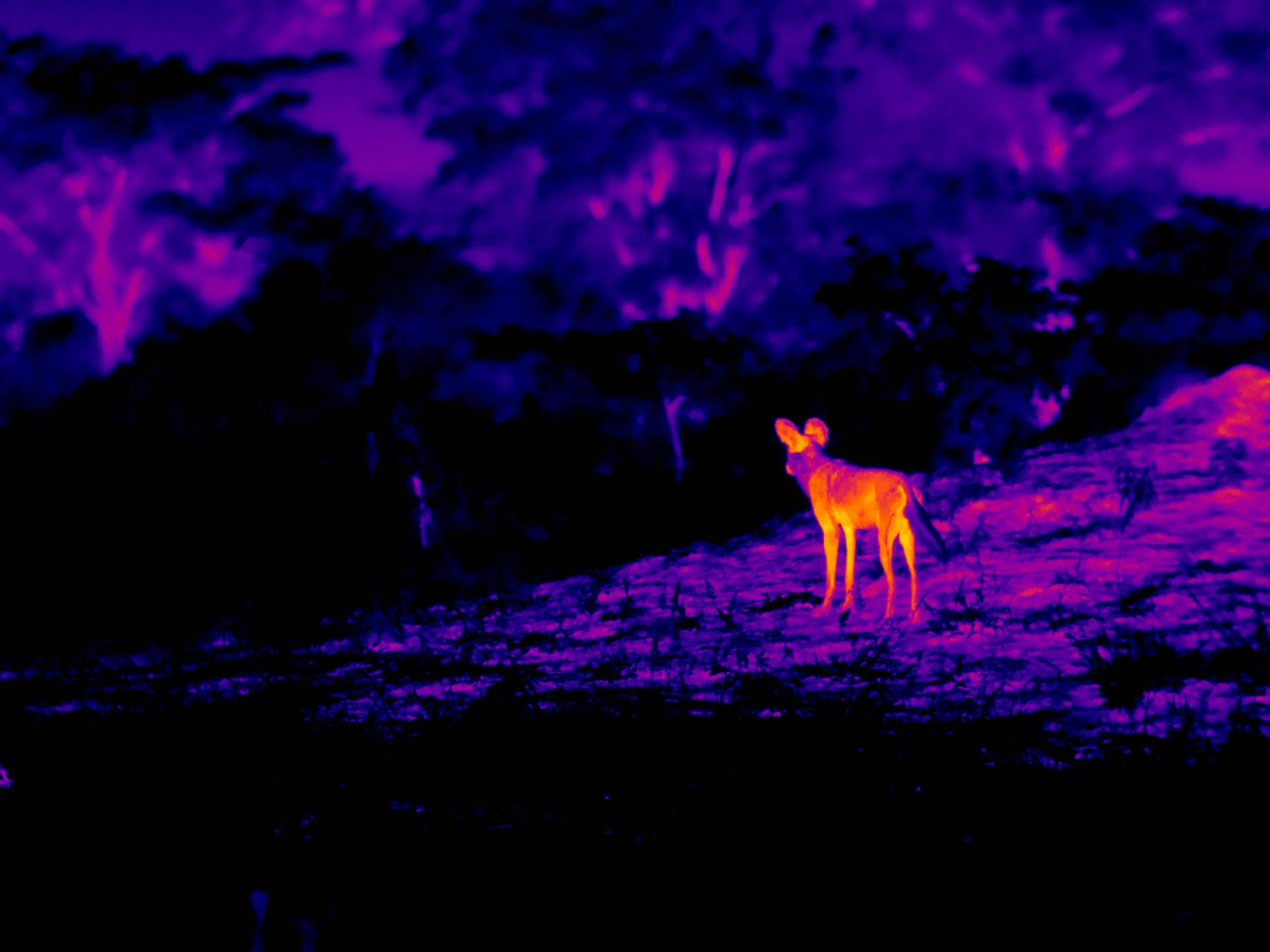
After you’ve talked yourself into needing a thermal monocular, your next questions should be about capability and cost.
Capability
Do you need to share videos with your buddies? Then make sure to pick a viewer with easy image sharing, and the best of the bunch have mobile apps that enable sharing. Will you be using it in sub-zero conditions? If so, consider battery run time. And you should critically assess your tech skills, because most of these units require a fair amount of digital savvy to get up and running, and then to get the most out of their capabilities.
All these thermal units have different viewing modes. The industry standard has become some variation of these palettes: white hot, black hot, rainbow, and red hot. And most devices have some sort of on-board recording feature, but there’s a wide range of capabilities, including built-in Wi-Fi and Bluetooth that allow users to share images.
As you’re looking over the field, also take note of the imaging capabilities of various devices. Some have extremely rich resolution, thanks to large objective lenses that gather more detail. Others deliver sharp renditions of the image because of high-resolution screens, and still others use more or fewer pixels to influence the image. The best have high scores in each of these three categories; others might compensate for poor resolution with a sharp screen.
Be aware of the limitations of the monoculars I’ve reviwed. As a class, they are designed to identify thermal variations (the night-vision and infrared devices amplify ambient light). They’re not designed as targeting aids or riflescopes – we’ll cover that category of thermals in another post. This is an important consideration, because if you’re looking for a thermal to get you started in nighttime hog or predator hunting, then you’re probably better off investing in a thermal scope or clip on.
Cost
Next, how much are you willing to spend on a thermal viewer? Products in this roundup range in price from about $400 up to well over $3,500. Because entry-level products generally tether to your phone, their versatility is limited. But the higher-end thermal viewers offer so much resolution and imaging talent that unless you’re using the devices frequently, you may be paying for more capability than you need.
The thermal or night-vision optic that’s right for you will depend on how you’ll use it. If you simply want to know what goes bump in the night, a simple hand-held thermal is a good choice for detection, and is by far the most cost-effective category of this class of optics. Most have on-board recording of both video and still images, various display modes, and are housed in compact, ergonomic bodies. Expect to pay anywhere from $650 to $2,500 for these units.
The least expensive units are those that connect to smart phones. Because of their diminutive size and modest on-board controls, they have limited resolution, but they can cost anywhere from $400 to about $800.
Of course if you want to clearly identify objects at long distances, record HD video, and range targets, expect to pay well over $3,000. If you also want a monocular that works as a clip-on weapon sight, with the same capability, you can expect to pay $6,000 to $17,000.
Why Are Thermal Monoculars so Expensive?
In terms of cost, you’re mainly paying for two attributes. For thermal units, the first is the heat-sensing lens. It’s made of a special crystal called germanium that, when shaped into a lens, blocks extraneous wavelengths and boosts temperature differentials. And you’re paying for image processing speed and resolution. An expensive thermal allows you to clearly identify animals and an inexpensive one will show you an animal-shaped blobs. It’s like the difference between the first cellphone cameras and the latest iPhone model.
Final Thoughts on the Best Thermal Monoculars
Thermal and night-vision devices are an important and exciting new category of “optics,” but they are so varied in terms of their capabilities, field-worthiness, and prices that my goal for this piece wasn’t to exhaustively review each product but talk about that variability and applicability for a range of tasks.
Because the category is so new, there are still many blind spots about which devices will best serve consumers’ needs. How useful are hand-held thermal monoculars? And when it comes to cameras, is a night-vision/infrared unit more useful than a thermal device? These are high-dollar items, so getting a good grounding in the capabilities of each platform is a necessary first step to being an informed consumer.
These are all sophisticated electronics, and you’re going to want to investigate the specific attributes of a prospective purchase. Pay attention to sensor and display resolution, frame rates of video recording, and sensitivity of thermal detection. And inquire about warranties. These are all expensive purchases of relatively fragile devices, and you want to ensure you have solid protection in case of a malfunction.

